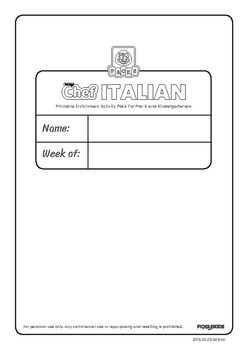FREE (Eng/Math) Italian Food Activity Pack for Preschoolers (Print Friendly)
- PDF
Description
2 Hours of fun-filled Italian cuisine themed activities with lots of learning objectives
This is the first edition of our preschool Piqolo Packs. It is a fun-filled Italian food and culture themed activity pack with lots of learning objectives (language, math, practical life skills etc). Use this pack to start a conversation with your child about Italy... it’s people, it’s culture and it’s delicious food.
Use this opportunity to help them learn more about nutrition and the ingredients used in your own household. This pack comes in both printable and interactive digital versions. Some parental guidance would make the activities more meaningful for the child.
Estimated activity time
1 to 2.5 hours depending on child’s age and interest level. An average of 15 minutes per activity depending on activity type and child’s age
Versions Available
Interactive Digital PDF for iPad/Apple Pencil
Printable PDF - Full Colour
Printable PDF - Print Friendly (This copy)
The interactive version can be used directly on the iPad and is clickable allowing users to reveal the correct answers (self-checking mechanism). It is fully coloured while the printable version is mostly in black and white to make it printer friendly.
System Requirements
The interactive version can be used via the Apple Books app on the following devices:
iPad Pro 11-inch, iPad Pro 12.9-inch, iPad Pro 12.9-inch, iPad Pro 10.5-inch, iPad Pro 9.7-inch, iPad (6th generation)
Content
- 1 instruction manual
- 12 activity sheets
- 15 piece cutouts (printable version only)
- 24 printable full coloured cue cards
- 1 recipe with shopping list
- 9 fun facts about Italian food and culture
Activity sheets
- Complete My Italian Meal: Phonics - a practice of long ‘o’ vowel sounds
- Where is My Antipasti: Cognition - a memory game
- Counting Tomathoes: Math - a practice to learn addition and subtraction using counters
- What’s In The Sauce: Cognition - teaches the child to match objects
- What’s Missing In The Sauce: Language - an activity that teaches kids to recognise words and how to search for key information.
- Line ‘em Pasta Up: Cognition - teaches pattern recognition
- Slice Slice of Pizza Baby: Math - this activity teaches simple time and math.
- Count Pasta Fasta: Math - teaches shape recognition, counting and focus.
- Lil Italian Garden: Phonics - works on your child’s knowledge of beginning sounds.
- La Mia Pizza: Creativity - helps with their artistic expression as they create their own pizza.
- Lil Cooking Class: Practical Life Skills - Our Nonna’s Mushroom Risotto recipe that comes with an ingredient checklist helps your child learn food preparation. The shopping list attached to the recipe acts as checklist when going grocery shopping. The symbols will make searching for the ingredient easier for the child
- Livin La Dolce Vita: Self-mastery - This weekly journal teaches your child autonomy and responsibility over their own learning journey. Everyday, they can write down (with help for younger kids) what they have learnt over the week and colour the badge to symbolise the end of the learning day.





